
|
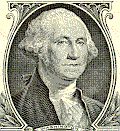 |

|
|---|
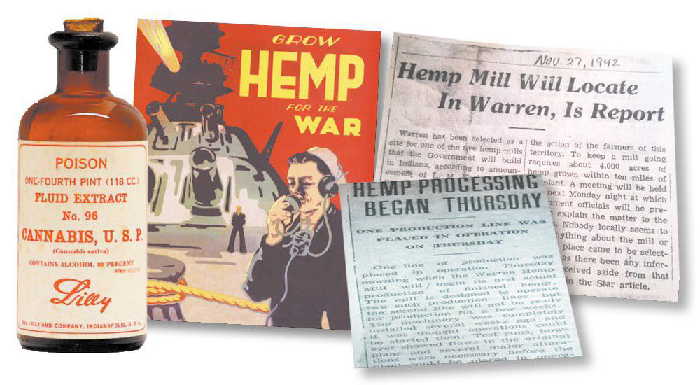
OF LEGALIZING MARIJUANA IN OKLAHOMA
4.0 - HISTORICAL REFERENCES:
AN EXTREMELY BRIEF HISTORY OF OUR MARIJUANA LAWS:
By whatever name is used, “Marijuana”, “Cannabis” and “Industrial Hemp” being the most common, this country has always had a turbulent relationship with this plant. At one time (during colonial days), it was even AGAINST THE LAW, not to grow marijuana. [7] That’s right; ---AGAINST THE LAW NOT TO GROW INDUSTRIAL HEMP (aka the marijuana plant). If you didn’t grow it, you would be seen as a criminal. And here we ask the reader to accept our word for it that the colonial governments were not doing this for the sake of the unwashed hippie. But instead due to hemp’s vital commercial as well as military significance in an age of sailing ships. Proof of that lies in George Washington’s famous quotation; “Hemp Grow It Everywhere” [8] , and yes he was a Hemp grower. And Yes, Thomas Jefferson (who probably was also a marijuana smugger) did invent/create an agricultural instrument to assist with Hemp production, etc. [9]
However, after the civil war, while the economic/Industrial importance of hemp cordage remained high, the same could not be said of our Home Grown Hemp agricultural sector, which entered a steep decline. The reason for this paradox was simple. It was cheaper to import raw hemp stalks, then it was to grow them domestically. Growing them (given the technology of the time) was simply a very labor-intensive industry. And recalling that the civil war ended slavery here in this country . . . let’s just say that Hemp growing was better suited for other locations, etc.
MISSISSIPPI 1890: --- Now comes the ugly part. While historians differ as to exactly where our present day drug laws came from, it is clear that many roads led to Mississippi’s 1890. [10] That being the year that the state of Mississippi had a Constitutional Convention, which while NOT creating the first drug laws themselves, created the mechanisms which, “Sure as Shooting,” lead to its creation. The Constitution is so infamous that it can easily be located via the Internet on various sites.
Simply stated, it appears that its main (if not it’s only goal) was to keep the black community in its place. And much can be said about its amendments; --- Example; It assures “every child in the state a quality education, in ‘Separate But Equal School facilities’, etc. But its most interesting feature was Article 12, Sec. 241, which restricted right to vote, to those who couldn’t pass an intelligent test, didn’t pay a poll tax . . . etc., as well as disenfranchised certain kinds of convicted criminals. Something, not really new, disenfranchisement of criminals had been going on since colonial times. What was new was that this constitution specified that ONLY SELECTED CRIMES would qualify the offender for disenfranchisement. Crimes that (surprise, surprise) were being committed almost exclusively by blacks at that time. Example; House burglary, an almost exclusively black crime at the time) is on the list, yet murder being an equal opportunity crime among all races at the time was not.
And best of all, by taking advantage of this loophole in the US constitution, allowed it to withstand court challenges. Thus the state was legally able to disenfranchise incredibly large numbers of blacks. In fact it was so successful that it soon became a model used by various other states (both north and south), which also had (ah) worries about black voters.
A situation which still haunts us into modern times. Example: Some time ago, it was noticed that Paterson New Jersey, while having a large black population, had very few African American registered voters. So a voter registration campaign was launched. However, when the campaign was actually initiated it turned out that somewhere around a third of all African American males living in Paterson N.J., were ineligible to vote due to felony convictions. In fact, the number of all African American males with felony convictions stands today at around 20%, while in the general population the figure is less than 2%. And this is in our era, with so many video cameras in place. One can only imagine what it must have been like to have lived in pre-Civil rights Mississippi. When police (ah, how shall we say it), had less restraints on who they arrested and what kind of drugs (or knives, or whatever) they planted as evidence. Convicting any uppity up Negro must have been easy breezy back then, and the best part was that not only did you intimidate all the other uppity-up Negro’s, but you didn’t have to spend too much money on incarceration costs, since all that was required for disenfranchisement was a conviction. Even a conviction and a fifty-cent fine was more then enough.
ENTER THE BROWN SKIN MARIJUANA’S: -- It doesn’t take too much imagination to figure out where the Brown Skin Marijuana’s enter into the picture. Simply put, it was something Blacks and Browns were doing, but not White. Thus fertile grown for a new drug law. A situation which, given the thousands of Medical Cannabis medicines that could be bought legally in drugstores at the time, a somewhat awkward situation.[11] Even here in Oklahoma, it was not uncommon for various County Sheriff’s to hand out medicines contain marijuana to their prisoners. [12]
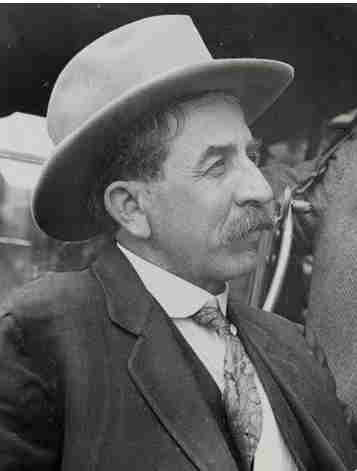
Governor Alfalfa Bill Murray |
But no matter, just 12 years after the Tulsa Race Riot (1933), Oklahoma Governor Alfalfa Murray, (whose very name conjures ups all sort of things) signed our newly passed marijuana statues into law. For those of you not native to Oklahoma, he was the kind of guy who at his inaurual speech went up and said:
“I’m Here to Help . .. I’m Here to Help the poor white folks . . I’m Here to Help the niggers I‘m Here to Help . . . And boy did he ever helped out all right. . . . But that is a different story, lets just say that he was a man of his time and throughout his political carreer he fought for Jim Crow laws as a means of keeping black people in their place. |
|---|
And as predicted, the end result of the new law, meaning those arrested under it, were very disproportionally non-whites. According to quick newspaper scans, the vast majority of those arrested having Spanish sounding surnames. And while whites came up second, blacks (very disproportionately to their numbers) came in a close third. [13]
REEFER MADNESS; THE 1930’S BRING ON THE DARK AGES: -- So much has been written about what happened during the Hysteria Campaign that occurred in the 1930’s that no real attempt will be made to deal with it here. Instead we will simply allow an Encyclopedic definition to speak for itself: *
WEBSTER’S ENCYCLOPEDIC DICTIONARY OF THE ENGLISH LANGUAGEAnd while the above definition might seem laughable to most of us today, we must not underestimate the climate of hysteria that the campaign created. To this day there are still those who believe it.
Copyright 1957 – H.S. STUTTMAN Co.
marijuana or marihuana (ma re hwa na) n. A weed or herb, growing in many parts of North America; the dried leaves of the plant, which have narcotic qualities when smoked in cigarettes; sometimes called the assassin of youth. Marijuana, or Hashish, a subtle, crazing drug which is being surreptitiously sold in U.S. in the form of cigarettes. Narcotic officials named it 'The Assassin of Youth,' and state that it is as dangerous as a coiled rattlesnake. Its effects when smoked vary with different Individuals. It may make of its victim a philosopher, a joyous reveler, a mad insensate, or a fiendish murderer. Its purveyors whisper into the ears of Am. youth the wonders of a new cigarette with a real thrill, and without harmful effects. Students are lured to its use by promises of resultant keenness of mind, the easy solving of problems, an aid in exams. An addict was hanged in Baltimore in 1937 for a criminal assault on a ten-year-old girl. In Fla. a crazed youth killed his father, mother, two brothers, and a sister. In more than 30 cases of murder or degenerate sex crimes in 1937, marijuana proved to be a contributing cause. See Hashish.
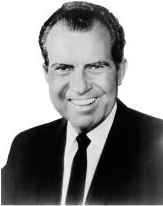 RICHARD NIXON AND BRINGING HOME THE BACON:
RICHARD NIXON AND BRINGING HOME THE BACON:In the early 1970's, then President Richard Millhouse Nixon’s launched his “War On Drugs, ” which in turn created various programs to help state and local authorities fight drug abuse. Soon Federal grant monies, not local law enforcement needs began determining priorities.
As the Wall-Street-Journal stated: [14]
“Shasta County (Ca.) Sheriff Tom Bosenko, his budget under pressure in a weak economy, has laid off staff, reduced patrols and even released jail inmates. But there’s one mission on which he’s spending more than in recent years: pot busts. . . The reason is simple: If he steps up his pursuit of marijuana growers, his department is eligible for roughly half a million dollars a year in federal anti-drug funding, helping save some jobs. The majority of the funding would have to be used to fight pot. Marijuana may not be the county’s most pressing crime problem, the sheriff says, but “it’s where the money is.”So much money started to flood local law enforcement that like all corrupting influences, even “Eliot Ness and his Untouchables” wouldn’t be able to resist the temptation. Which is reflected in the following chart:
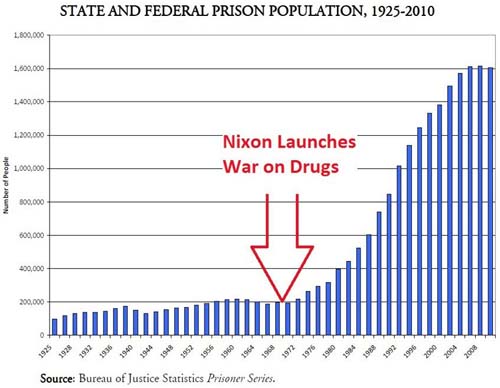
Simply put, as minimum sentences and a get tough on crime attitude started to take hold, so did our prison population, with no one daring to ask the obvious question; WHY? Just because some guy in Mississippi didn’t like black people (and there’s no other reason for the law), why should we have to suffer over here.
* For those who want for info on the subject, we recommend the following website:
www.ReeferMadnessMuseum.org
WANT TO KNOW MORE:
=====================
Due to space / download time considerations, only selected materials are displayed. If you would like to obtain more information, feel free to contact the museum. All our material is available (at cost) on CD-Rom format.
CONTACT PAGE
 BUDGET REPORT PRIVIOUS SECTION |
 |
 BUDGET REPORT NEXT SECTION |
 BACK TO MAIN PAGE OKLAHOMA BUDGET REPORT |